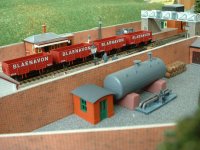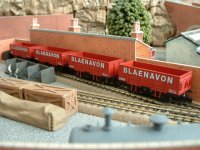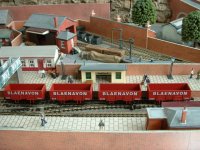One each of these four colourful and authentic wagons from the Dapol standard range,
The town of Blaenavon, or Blaenafon as any proud Welshman would have you spell it, lies at the head of the
Afon Llwyd valley some 25 miles north of the city of Cardiff. Until the mid-eighteenth century it had been an
isolated village on the edge of the bleak Gwent uplands, but then along came the Industrial Revolution, and life in
the Welsh valleys would never be the same again. Blaenavon was sitting bang on top of some of the biggest coal
deposits in the country, and where there was coal there was money to be made by digging it out. The first coal
mine in Blaenavon opened in 1782, followed by the first ironworks in 1789, and the mine owners and
ironmasters made themselves very wealthy men indeed. In 1836 the two industries were brought together
in the newly-formed Blaenavon Coal and Iron Company, and throughout the Victorian era this industrial
giant went from strength to strength. In 1866 the railways got in on the act, with a line operated by the mighty
London and North Western Railway leading northeastwards to the LNWR's network in the English midlands,
followed eight years later by a GWR connection southwards through Pontypool to Newport docks, and for the
best part of a century these lines would carry the coal and iron of Blaenavon on its journey to the homes
and factories of the world.
By the 1920s the LNWR had been absorbed into the newly-created LMS, but the mines were still going strong, and the ironworks had become steelworks. The GWR, never
backward in looking forward, thought that sheets of steel would make bigger and stronger mineral wagons than
the traditional wooden planks. Their wagonworks came up with a simple and robust design for a steel wagon
which could carry 20 tons of coal, and the GWR's management set about selling this new-fangled notion of
high-capacity low-maintenance vehicles to their customers. Organisations like the Blaenavon Coal and Iron
Company hadn't got where they were without embracing new technology, and when they saw the new steel
wagons it was love at first sight. Pretty soon their coal output was travelling over LMS and GWR metals in
rakes of 20 ton steel wagons, painted up in a fetching shade of red oxide and proudly lettered with the
company name.
But the good times didn't last, and steel production in Blaenavon came to an end in 1938, out-competed
by more modern steelworks nearer to the docks. Coal mining has gone now too, with the aptly named Big Pit
closing in 1980, and with the mine went the railway. The mine and the ironworks are now museums, with the
whole area being a World Heritage Site, and happily a short section of the old GWR line is being operated
in preservation by the Pontypool and Blaenavon Railway. Unfortunately they don't have any of the old
Blaenavon 20 ton steel wagons, but you can have a rake of them on your layout with our Blaenavon set.
Please note that these wagons are boxed individually.
Loads are not included.
|







